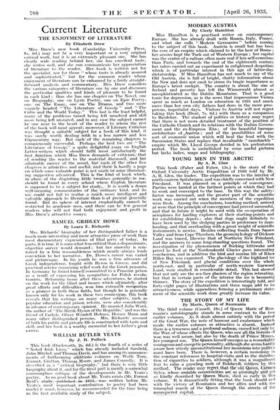YOUNG MEN IN THE ARCTIC
. By A. R. Glen
This book (Faber and Faber, .15s.) is the story of the. Oxford University Arctic Expedition of 1933 told by Mr. A; R. Glen, the leader. The expedition was to the interior of north-eastern Spitzbergen, and was chiefly concerned with New Friesland. It was planned on a principle of convergence. Parties were landed at the farthest points at which they had to work and converged to the base. In this way the safety factor was increased, and the greater part of the scientific: work was carried out when the members of the expedition were fresh. Among the conclusions, touching method, arrived' at were that the principle of convergence had proved successful,' and that in future it might be used with the co-operation of aeroplanes for landing explorers at their starting-points and for establishing depots ; also that dogs ought definitely to have been used by the sledging parties in preference to man- hauling, and that overloading with a great weight of scientific instruments is unwise. Besides collecting fossils from Sassen Valley and from Cape Thordsen, the geomorphology of Dickson Land was traced, likewise that of Northern New Friesland, and the answers to some long-standing questions found. The investigation of the phenomenon of flocking kittiwake and petrel to feed at the Nordenskeold Glacier gave interesting conclusions, and in addition the bird and marine life of Klass Bitten Bay was examined. The glaciology of the highland ice of New Friesland, and glacial conditions over the whole north-east, and in particular of north-western Garwood Land, were studied in considerable detail. This last showed that not only are the sea-face glaciers of the region retreating, but that in certain parts of the interior the ice is becoming thinner. The story of the expedition is interestingly told, and forty-eight pages of illustrations and three maps add to its attractiveness, while appendices forming a preliminary state- ment of the scientific work done greatly increase its value.










































 Previous page
Previous page